A) 1 or 3
B) 1 or 4
C) 2 or 3
D) 2 or 4
Correct Answer

verified
Correct Answer
verified
Multiple Choice
Immediately after karyogamy occurs,which term applies?
A) plasmogamy
B) heterokaryotic
C) dikaryotic
D) diploid
Correct Answer

verified
Correct Answer
verified
Multiple Choice
When adult amphibian skin harbours populations of the bacterium,Janthinobacterium lividum (Jl) ,chytrid infection seems to be inhibited.Which of the following represents the best experimental design for conclusively determining whether this inhibition is real?
A) Inoculate uninfected amphibians with Jl, and determine whether the amphibians continue to remain uninfected by chytrids.
B) Inoculate infected amphibians with Jl, and determine whether the amphibians recover from infection by chytrids.
C) Take infected amphibians and assign them to two populations. Leave one population alone; inoculate the other with Jl. Measure the rate at which infection proceeds in both populations.
D) Take infected amphibians and assign them to two populations. Inoculate one population with a high dose of Jl; inoculate the other with a low dose of Jl. Measure the survival frequency in both populations.
Correct Answer

verified
Correct Answer
verified
Multiple Choice
Both fungus-derived antibiotics and hallucinogens used by humans probably evolved in fungi as a means to
A) reduce competition for nutrients.
B) help humanity survive.
C) promote their ingestion of foodstuffs.
D) eliminate other fungi.
E) discourage animal predators.
Correct Answer

verified
Correct Answer
verified
Multiple Choice
Do cell walls of fungi differ from cell walls of plants?
A) Yes; cell walls of fungi contain chitin, cell walls of plants contain cellulose.
B) No; cell walls of fungi and plants contain chitin.
C) No; cell walls of fungi and plants contain cellulose.
D) Yes; cell walls of fungi contain peptidoglycan, cell walls of plants contain cellulose.
E) Yes; cell walls of fungi contain lignin, cell walls of plants contain cellulose.
Correct Answer

verified
Correct Answer
verified
Multiple Choice
If all of their nuclei are equally active transcriptionally,then the cells of both dikaryotic and heterokaryotic fungi,in terms of the gene products they can make,are essentially
A) haploid.
B) diploid.
C) alloploid.
D) completely homozygous.
E) completely hemizygous.
Correct Answer

verified
Correct Answer
verified
Multiple Choice
The next few questions refer to the following phylogenetic trees.
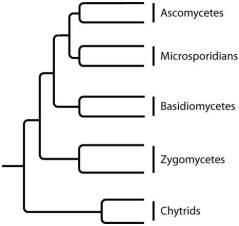 I.
I.
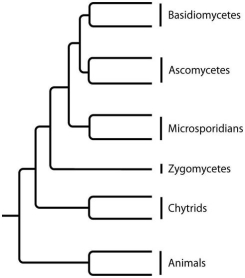 II.
II.
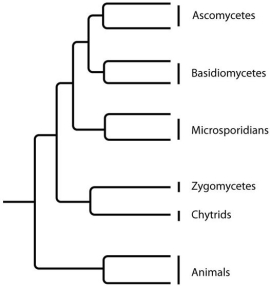 III.
III.
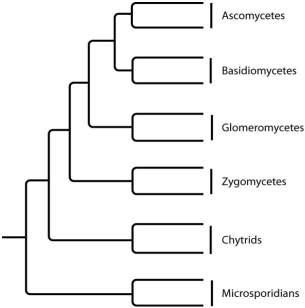 IV.
-Which tree depicts the closest relationship between zygomycetes and chytrids?
IV.
-Which tree depicts the closest relationship between zygomycetes and chytrids?
A) I
B) II
C) III
D) IV
Correct Answer

verified
Correct Answer
verified
Multiple Choice
What do fungi and arthropods have in common?
A) Both groups are commonly coenocytic.
B) The haploid state is dominant in both groups.
C) Both groups are predominantly heterotrophs that ingest their food.
D) The protective coats of both groups are made of chitin.
E) Both groups have cell walls.
Correct Answer

verified
Correct Answer
verified
Multiple Choice
In both lichens and mycorrhizae,what does the fungal partner provide to its photosynthetic partner?
A) carbohydrates
B) fixed nitrogen
C) antibiotics
D) water and minerals
E) protection from harmful UV
Correct Answer

verified
Correct Answer
verified
Multiple Choice
Mycorrhizae are to the roots of vascular plants as endophytes are to vascular plants'
A) leaf mesophyll.
B) stem apical meristems.
C) root apical meristems
D) xylem.
E) waxy cuticle.
Correct Answer

verified
Correct Answer
verified
Multiple Choice
The following questions refer to the description below. A lichen is a mutualistic association between a fungus and a green algae or cyanobacteria.There are clear morphological differences in lichen body form; some have flat bodies and are very close together,others have leaf-like bodies,and still others grow upright.The association between the two organisms is so complete that lichens are classified as a single organism. -Lichens are found in a wide variety of habitats,including rocks,soil,tree bark,buildings,etc.Aging of lichens has shown that some are thousands of years old; how is this possible when you see that some of these lichens are very small?
A) When resources such as water is not available, the lichens enter a potentially long dormant phase, and thus grow very slowly.
B) It is not possible, and is likely an error in the dating technique.
C) It is not possible because small organisms are not long-lived.
D) They can die off if air pollution is bad and then revive and continue growing.
E) They can live long if they are in a city and protected from extreme cold and wind.
Correct Answer

verified
Correct Answer
verified
Multiple Choice
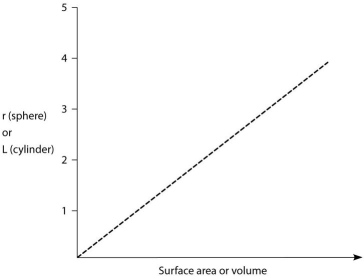 -Both axes of the graph are linear.Thus,the shape of the line plotted on this graph most accurately depicts the
-Both axes of the graph are linear.Thus,the shape of the line plotted on this graph most accurately depicts the
A) volume of a sphere as the radius, r, increases.
B) surface area of a sphere as the radius, r, increases.
C) volume of a cylinder as length, L, increases.
D) surface area of a cylinder as length, L, increases.
Correct Answer

verified
Correct Answer
verified
Multiple Choice
Use the following information to answer the questions below. Rose-picker's disease is caused by the yeast,Sporothrix schenkii.The yeast grows on the exteriors of rose-bush thorns.If a human gets pricked by such a thorn,the yeasts can be introduced under the skin.The yeasts then assume a hyphal morphology and grow along the interiors of lymphatic vessels until they reach a lymph node.This often results in the accumulation of pus in the lymph node,which subsequently ulcerates through the skin surface and then drains. -Say S.schenkii had initially been classified as a deuteromycete.Asci were later discovered in the pus that oozed from an ulcerated lymph node,and the spores therein germinated,giving rise to S.schenkii yeasts.Which two of these are conclusions that make sense on the basis of this information? 1) S.schenkii produces asexual spores within lymph nodes. 2) S.schenkii should be reclassified. 3) S.schenkii continues to have no known sexual stage. 4) The hyphae growing in lymphatic vessels probably belonged to a different fungal species. 5) S.schenkii yeasts belonging to two different mating strains were introduced by the same thorn prick.
A) 1 and 3
B) 1 and 5
C) 2 and 3
D) 2 and 5
E) 4 and 5
Correct Answer

verified
Correct Answer
verified
Multiple Choice
Use the following information to answer the questions below. Recent genetic studies of the structure of microsporidian genomes,as well as the sequences of their tubulin genes and the gene for RNA polymerase II,indicate that microsporidians are closely related to the fungi.Microsporidians lack flagella,centrioles,peroxisomes,and mitochondria (although they do have degenerate mitochondria,called mitosomes) .They have the smallest genome of any eukaryote,and it is a genome that changes quickly.The genome is contained within two haploid nuclei.All microsporidians are obligate intracellular parasites.They use a unique organelle called a polar filament to gain access to the cells of their hosts.One species causes chronic diarrhea in AIDS patients.Another parasitizes Anopheles gambiae,the mosquito that transmits a fatal form of malaria to humans. -Given the eukaryotic structures they lack,it should be expected that microsporidians also lack
A) the "9 + 2 pattern" of microtubules.
B) chitin.
C) lysosomes.
D) nuclei.
E) centrosomes.
Correct Answer

verified
Correct Answer
verified
Multiple Choice
What accounts most directly for the extremely fast growth of a fungal mycelium?
A) rapid distribution of synthesized proteins by cytoplasmic streaming
B) a long tubular body shape
C) the readily available nutrients from their ingestive mode of nutrition
D) a dikaryotic condition that supplies greater amounts of proteins and nutrients
Correct Answer

verified
Correct Answer
verified
Multiple Choice
If all fungi in an environment that perform decomposition were to suddenly die,then which group of organisms should benefit most,due to the fact that their fungal competitors have been removed?
A) plants
B) protists
C) prokaryotes
D) animals
E) mutualistic fungi
Correct Answer

verified
Correct Answer
verified
Multiple Choice
The photosynthetic symbiont of a lichen is often
A) a moss.
B) a green alga.
C) a brown alga.
D) an ascomycete.
E) a small vascular plant.
Correct Answer

verified
Correct Answer
verified
Multiple Choice
Which of the following characteristics is shared by both chytrids and other kinds of fungi?
A) presence of flagella
B) zoospores
C) autotrophic mode of nutrition
D) cell walls of cellulose
E) nucleotide sequences of several genes
Correct Answer

verified
Correct Answer
verified
Multiple Choice
Basidiomycetes are the only fungal group capable of synthesizing lignin peroxidase.What advantage does this group of fungi have over other fungi because of this capability?
A) This is always the first group of fungi to begin any kind of plant decomposition.
B) This fungal group can break down the tough lignin, which cannot be harnessed for energy, to get to the more useful cellulose.
C) This is the only group of fungi that can use lignin for adenosine triphosphate (ATP) production.
D) This enzyme releases heat energy from the breakdown of lignin that is used to kill off competing fungi.
Correct Answer

verified
Correct Answer
verified
Multiple Choice
All fungi share which of the following characteristics?
A) symbiotic
B) heterotrophic
C) flagellated
D) pathogenic
E) act as decomposers
Correct Answer

verified
Correct Answer
verified
Showing 81 - 100 of 105
Related Exams